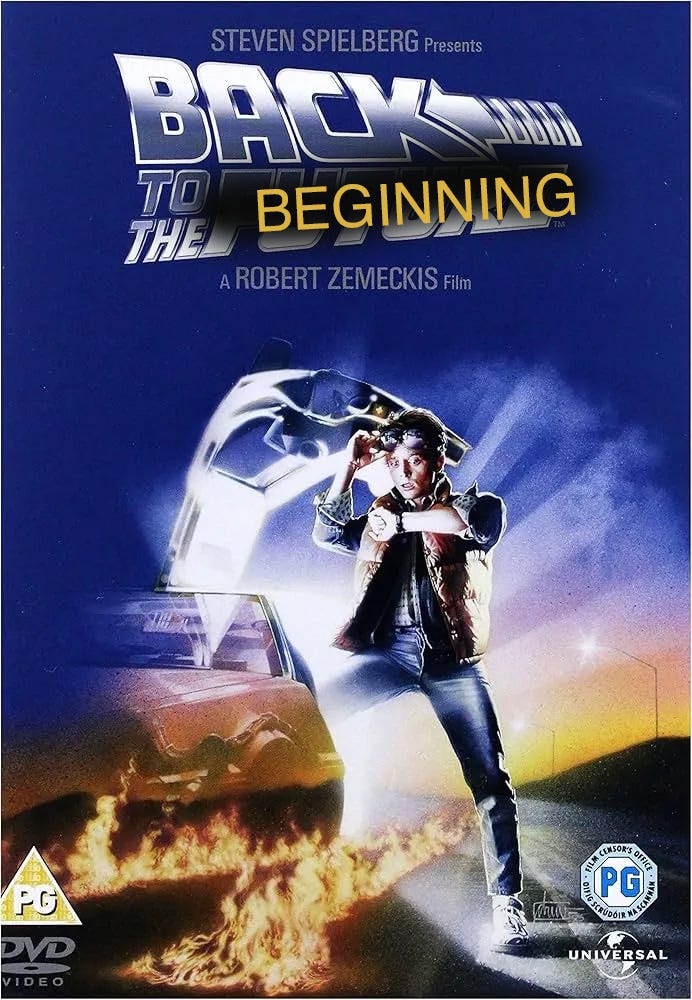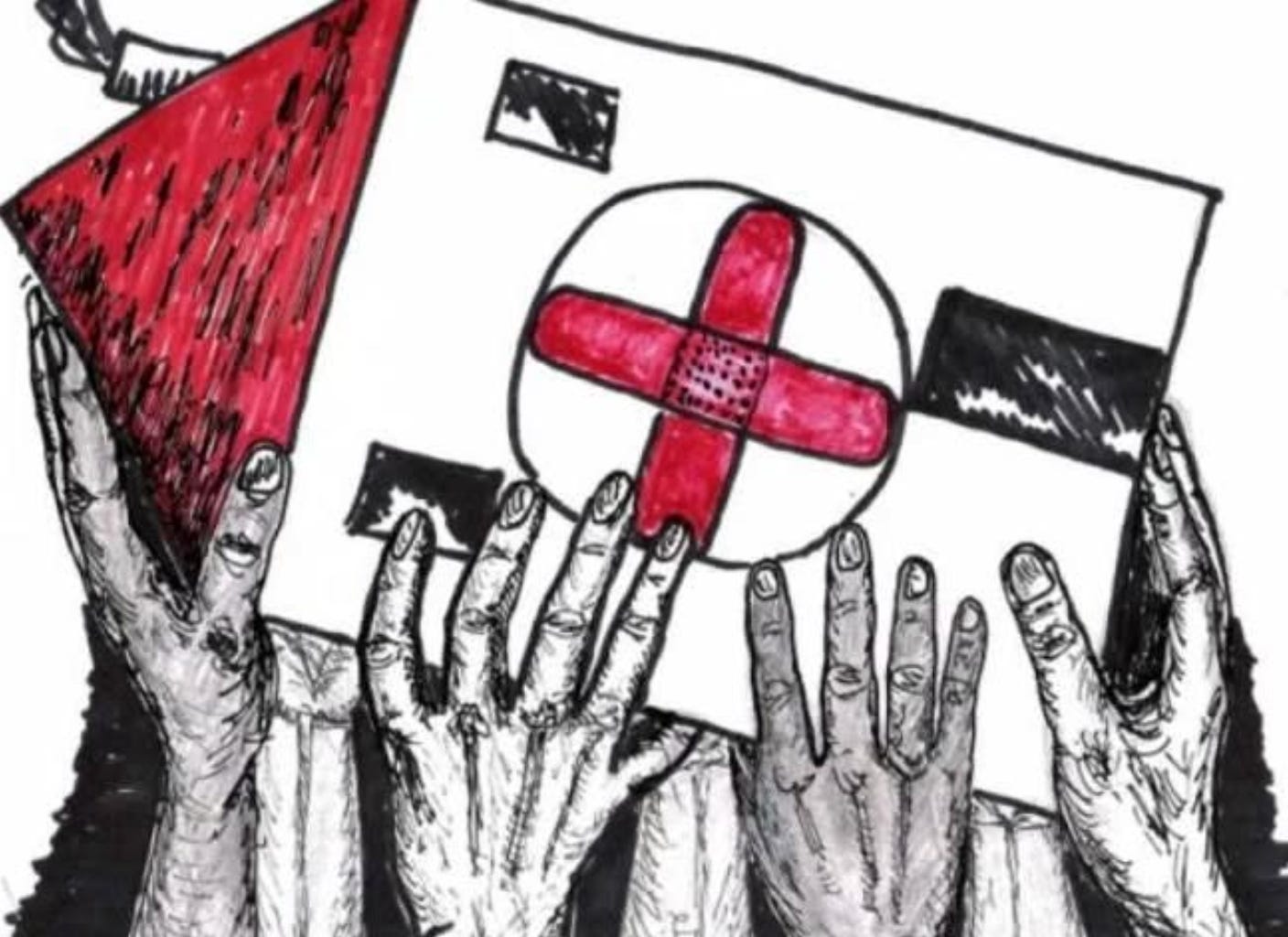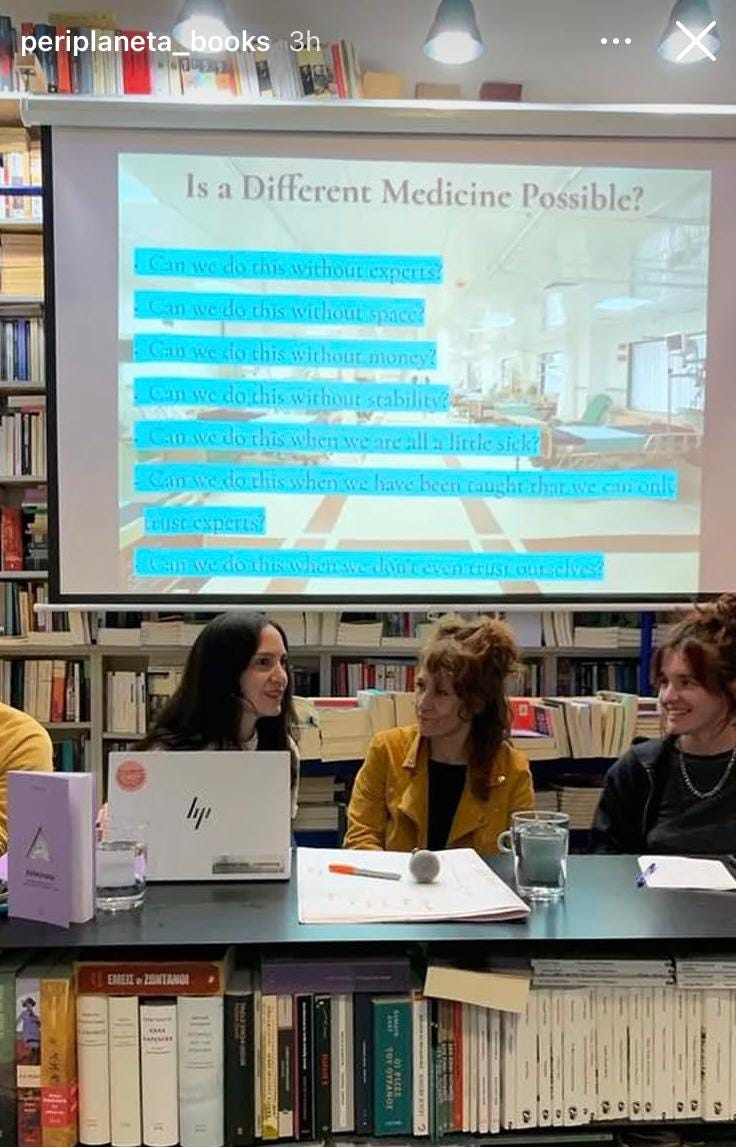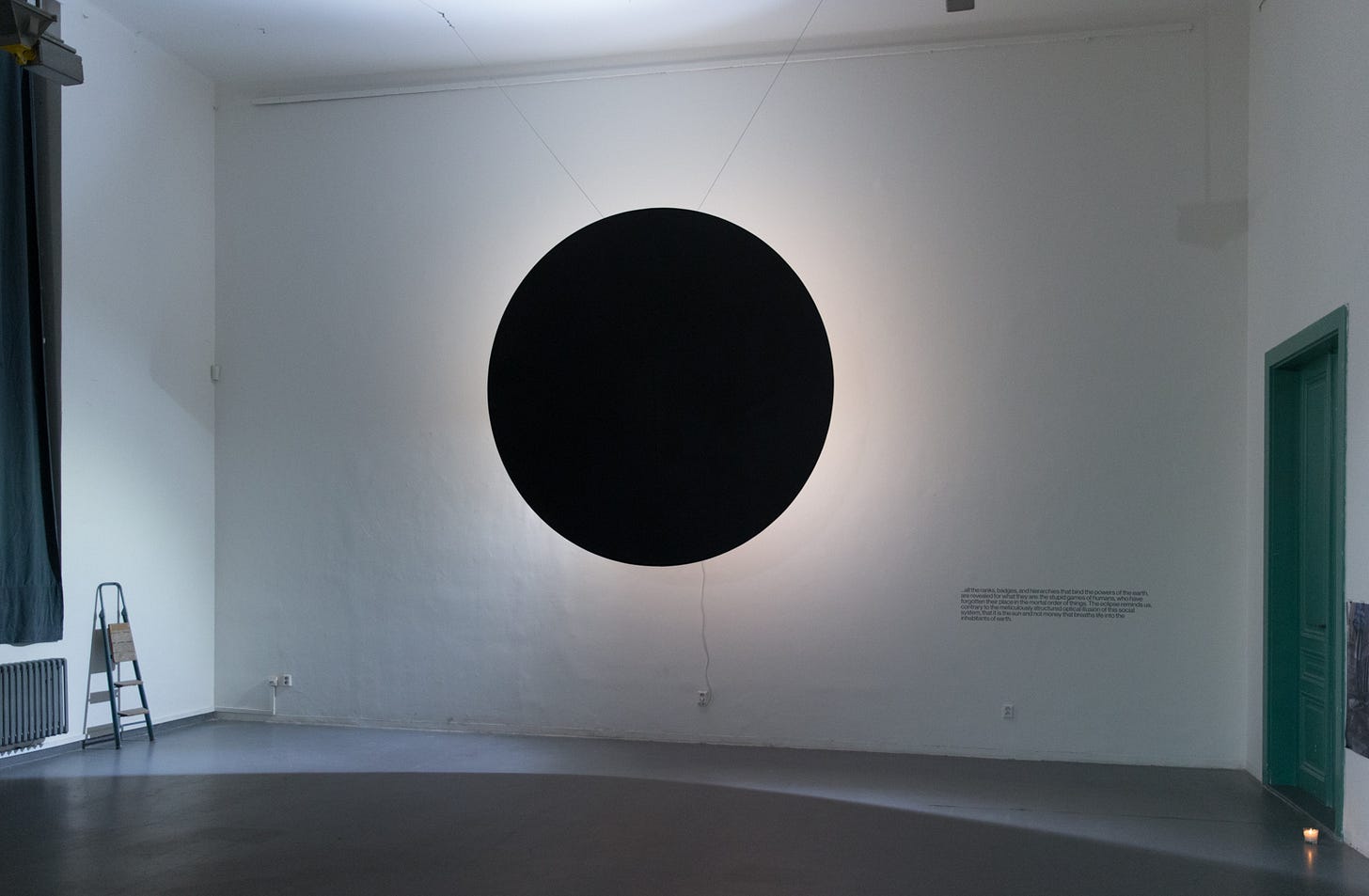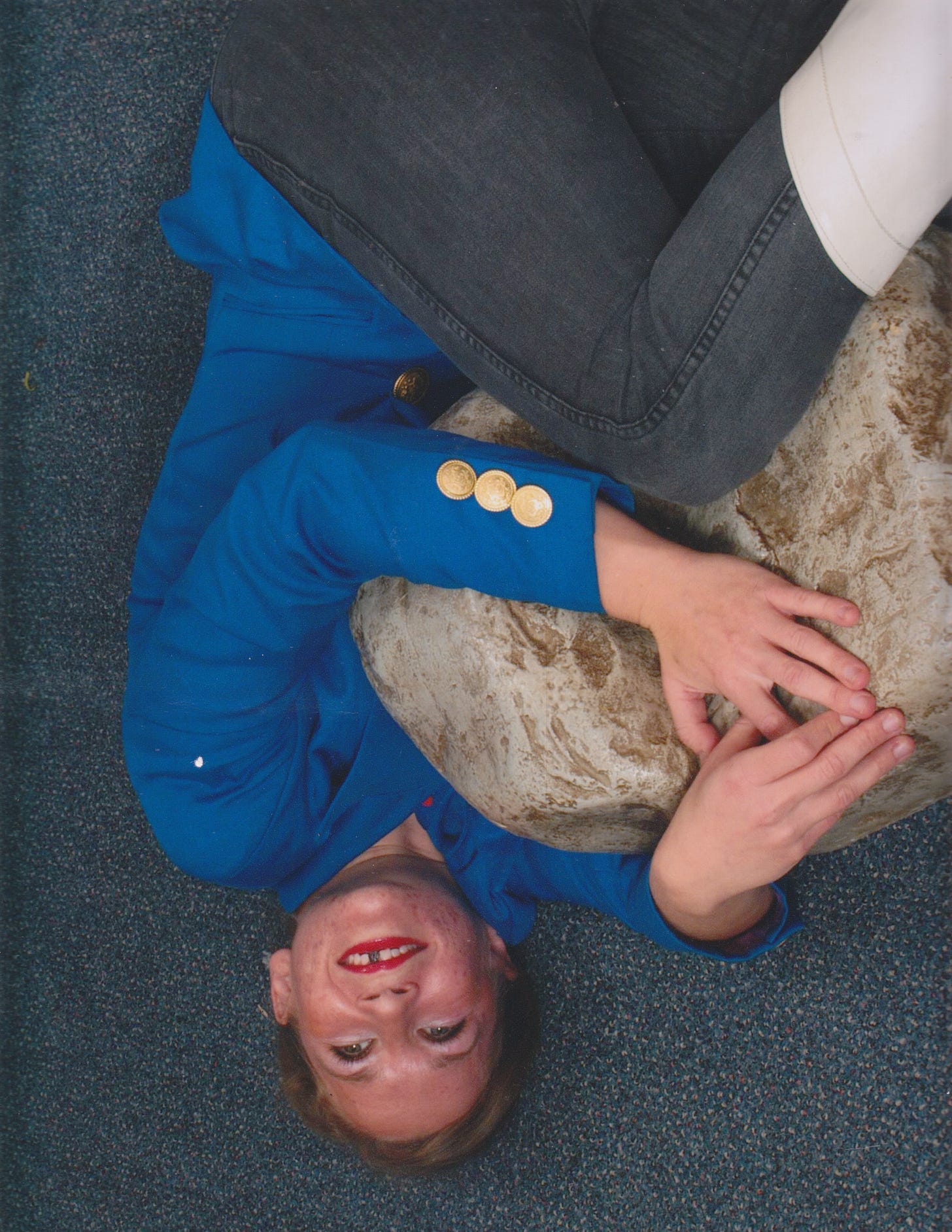On going back to the beginning + accepting a spiritual grammy in the apocalypse
A variation of this text was written for School of Commons_ Issues Journal 2024
Warning: A small and meaningful experience of success in the apocalypse is described here.
*If you make it to the end of this email, bless you! Down there you'll see a new hustle of mine, that you might want to get in on.
This is a text exploring the meaning of success in the apocalypse. What does it mean to win if we aren't shooting for growth, profit or other forms of escalation; if instead we look towards slow, steady and meaningful change? (and what the heck does that even mean?) For me, the completion of cycles is very significant in projects, and projects define much of my life and relationships, but there is often no way to talk about or mark these moments. This text follows the development of The Hologram as an 8 year long project (and going) and its path back to its roots.
When I talk about The Hologram publicly, I always talk about where it comes from. And now, so does everyone else who presents it. This is a part of the practice. For nearly 5 years, I and we have always said ‘it's really important where things come from’, but I never really knew the deeper significance of this phrase, though I am pretty sure it came from me.
What's the Hologram?
The Hologram (with subtitles)
Recently I met two collaborators and friends, Magdalena Jadwiga Härtelova and Maro Pantazidou, in Greece, where the people and the clinic that inspired The Hologram project reside. We were there to celebrate the new Greek (collective, cultural and linguistic) translation of the book I originally published with Pluto Press in 2020 called The Hologram: Feminist Peer to Peer Health for a Post-Pandemic Future. This translation project was organized by Maro, and the book was published and translated with Christos Pallas at Periplaneta Books.
Image of the Greek translation of The Hologram book, out from Periplaneta Books in Athens
Of all the book launches we've ever had, I was most excited to go to Thessaloniki, to revisit the clinic that was the home of the practice that changed my life, my work and all my relationships. I didn’t know what it would mean to launch the book there, and to revisit the story that I and we have been narrating in hundreds of Holographic conversations, presentations, and workshops for the past 8 years. This is the story of The Social Solidarity Clinic of Thessaloniki, and how I heard a rumor about their endeavour to give free, non-hierarchical care in response to a debt crisis.
The logo for The Social Solidarity Clinic of Thessaloniki
The people at the clinic (called Kia in Greek) have been working together for about a decade on something called The Integrative Model. This model invites a person (called an “incomer” and not a patient) to be seen by a practicing doctor, a therapist, and a volunteer/social worker at the same time. These three people ask about all parts of the person's life, outer, and inner worlds, in a collective practice in a tiny room with lots of affectionate seriousness, play and focus. They have been practicing and organizing the Integrative Model together through assemblies, with so much precision and learning, for so long. I really look up to them for what they do and how they do it.
This image was from our Athens book launch. Pictured, the yellow color coordinated shoulder of Paris, Maro, Cassie, and Magda.
We have basically taken the practice they do in their clinic, and figured out how we can do this ourselves, with our friends. In many ways, this practice (potentially) expands their wish for undoing hierarchy. But I wasn't sure if they would see it, and was incredibly nervous and excited to find out how it sat with them.
The day of the book launch in Thessaloniki I was so nervous that I could barely see and I didn't know why. I felt there was a pressure and possibility in the moment of reconnecting with the people and the place that inspired the project. Would they appreciate the grandchild that they did not consent to produce?
At the event we sat at a long table, alongside Ewa, a doctor, and Margarita, a dentist—activists and members of the team who work on the Integrative Model. It was such a relief to hear that, after I presented about The Hologram for ten minutes with Maro translating, Margarita said that we had more in common and more to discuss than she ever could have expected. I almost died of the strangest happiness! I literally felt like suddenly, I believed that I had some kind of integrity, I had the feeling like, in a world where I don't make much sense… I deserved to live?! I didn't understand why this meant so much, but I also did. Maro complimented me on making much less sense than usual at the book launch, because I was too emotionally overwhelmed. LOL!
That night, and the following night, we stayed up late into the night talking about the two models— in my head the big dog and the little dog met and the little dog wasn't so little. We were just two collectives using the same social technology in different ways, debating and learning from each other. It felt like going home, if home is a place where highly critical, very experienced, collectivists gather and organize care beyond what capitalism can dream.
This is an image of three Greek women, like the three fates, weaving destiny from inside a clinic. These three women are holding paperwork. To be specific, they are holding the anonymized and approximated health card of one of the incomers that they see at the Social Solidarity Clinic of Thessaloniki. These fates are reading parts aloud, making a short play that models how The Integrative Model works. This takes place at midnight on a Thursday in an exchange that they did with The Hologram inside Kia.
Returning to this particular origin of the project was always a wish of mine. When I met Maro in 2020 in some online events, we immediately connected over this wish— that somehow we both felt the strong impulse to bring the project back to the people who inspired it. This wish was always written into the project and returning the project to its origins felt like the end of a cycle. There’s no word that represents the significance of this moment where you close a cycle in a project, though it certainly is a defining point.
And like, what if life was defined by cycles instead of by years? Hey, you, can we do that after capitalism ends? I don’t think I trust linear time anymore to tell me where I am in life or what is important. I don’t know what to call this experience: a rare but actual success taking place in the apocalypse. Can I just call this our Grammy Award? If not, maybe it is my anti-institutional PhD or the birth of a more-than-human child? It feels important to name this moment in a world where most things that are rewarded, or that are supposed to be important are actually capitalist, patriarchal bullshit. This moment of going back to the beginning felt so significant, but there is no word for it in our reality that helps translate why or how it matters. I believe that we concluded the first full cycle of this big long project by going back to the beginning.
This is an image of Three Fates, which Cassie used at the online book launch of The Hologram book in 2020, co-hosted by Eyebeam and Pluto Press.
Every end has a million different beginnings, and every beginning produces a million different stories. Nothing is inevitable, but nothing is unpredictable. If we all stopped participating in linear time, focusing on moving forward with such anxious and fearful momentum, what would happen? What if we focused on our relationship to cycles, of how we work with the conditions we are born into, and how to actually leave the place (earth) better than we found it? And I am not just talking about some romantic idea of eating the appropriate soup for the season, when seasons are so wildly changing. I'm thinking about big and little social cycles of growth and death, of mistakes and revenge, of overcoming obstacles and celebrations. Of winning in a world where it feels like so much is closing or dying.
Ok so, why is it important to go back to the beginning?
It seems kind of obvious that you go back to the beginning of a project to revisit what the original need or wish was, and if it was met. It feels normal in a goal oriented world. And yet I feel that I need to do it, and it isn't just capitalism breathing down my neck, telling me to take what I've come for. For me it's a spiritual practice, to go back to the original need, wish or desire that defined why I or we started working on whatever we are working on right now. In this way, my past self checks in on my current self, and we figure out what the plan is.
When I go back to the beginning of any project, whether it is a relationship, an art project, an experiment, or a phase of life, I find it really interesting to remember where I was and what I wanted or needed from that project at the beginning. And then, I also like to remember what the needs of the world were at that time.
Each project comes from an idea, but that idea comes out of a real life situation in the world: a problem, a pain, an unfulfilled need, a lonely person outside the subway, a crack in the sidewalk. When I started The Hologram, I lived in California. I had just lost my dad, ended a relationship, lost my housing, ran out of money, and lost faith in doing work in the art world. I had spent a year digging a hole in the backyard of my Oakland apartment, without growing anything in the acidic dry soil. I worked on many projects with anti-debt activist groups (Strike Debt!) during the day, catered for elite assholes at night, and there was an incredible drought in California that we were pretending not to notice. Though I had many friends, I don't think I had a very easy time asking for help, and I sustained my energy and self worth by anxiously pleasing people and by making myself useful. I was a lone wolf living in the US with no health insurance, the year after my dad sacrificed his life to avoid medical debt after being abandoned by the privatized medical insurance system (yes the one who Luigi took revenge on) and its all encompassing logic of care for profit.
I was looking for good news outside of the debt system when I heard a rumor that there was a free clinic in Greece that was made in response to sovereign debt; that they aimed to give medical, social and emotional care to one person at a time for free. I was trying to feel what it was like to be in a world where there was enough care for everyone, where the care wasn't dependent on money, competition or individual heroes, and where I didn't feel so alone and personally responsible.
What is the need, wish, or desire behind the project you are working on right now?
Can you remember the original impetus, the taste in your mouth, the hunger or curiosity?
What did you need right then at the birthplace?
What did the world need?
One of my favorite authors, Leanne Betasamosake Simpson, writes indigenous theory in circles, through telling stories with all her human and non-human relations, of Indigenous Resurgence. AS WE HAVE ALWAYS DONE is a theory written in a full cycle, in a book, in a circle and it demands an end to capitalism, colonialism and all the cycles of domination that keep anyone alive from flourishing, starting with Indigenous people.
The Hologram also comes from the place that Leanne Betasamosake Simpson is from, in Anishinaabe Territory in what is now called Canada. As The Hologram grew into a larger social project, I lived in Thunder Bay, Canada. During the day, I ran workshops and gave talks about The Hologram. At night I was a part of an Indigenous Feminist patrol with and for Anishinaabe people and settlers to escape from police violence and extreme settler colonialism together.
Some of the practices within The Hologram are very literal translations of practices that we used within this direct action support work. One of my favorite parts of The Hologram, the Community of Practice, is an interpretation of a talking circle we did within our patrol group to work with difficult feelings. In the circle, everyone in our group was invited to speak as much as they liked, and to pass it on to the next person when they felt their words were complete. We went in a circle, and we let ourselves explore what was the beginning, or the root, of the conflict, and the beginning or root of our work. It emerged.
In The Hologram, this is done online or in person, also in a circle. One person at a time talks as long as they want about a tension or question they have about The Hologram practice, and then they invite the next person to do so, until everyone speaks. In the second round, we speak in the same order as in the first round, now inviting each person to respond to anything they heard from the others, with care and curiosity and without expertise. Community of Practice is a way that people who use The Hologram can connect with others and it takes the practice out of the realm of "cheap therapy replacement” and into the realm of a new form of social movement. If you ever want to come, please sign up for our newsletter or website for invitations each month.
This is a photo of some of the teepees that we made during an extremely cold Thunder Bay winter during COVID-19 lockdown. At this time, the shelters had minimal space to meet the needs of the large unhoused population, who were mostly Indigenous. Many people were sick with COVID, and the temperature went as low as -55 degrees Celsius at night. We had found several people who had lost their lives on the street. These structures were meant to host some of the people who were in need of shelter. They were made in traditional ways so that people could have a fire inside to stay warm. They were along a major street and were quickly made useful and we were surprised that the city allowed them to stay for a few weeks (if my memory is correct!).
In some ways, The Hologram has also begun to produce direct action support work in the spirit of the patrol that I was a part of. I think we may be entering a new stage, where we can now take on the spirit of our second parent (knowing that our parents are always a place and its people, that people are land, and that land is always ultimately our parent and our teacher). As more people practice The Hologram for longer periods of time, we can see more and more hologrammas making use of the stability they experience in The Hologram to become involved in risky direct action work to support others, to take risks for the lives of people affected by toxic power, near and far.
What is important?
Why are we doing this?
Is this good?
What's good in the apocalypse?
How does this relate to the current state of the world?
How does this produce life and not distraction?
Does this project create or destroy energy?
The day of the book launch in Thessaloniki I was so nervous that I could barely see and I didn't know why. There's something about going back to the beginning–to meet the ancestors and to touch the memories–that takes away a lot of illusions and confusions. And maybe that's what we in the flat white dimension (where we drink strong coffee and do vigorous exercise to quiet the anxiety we have about the burning planet so we can continue to work and pay rent) are learning right now: how to get rid of the illusions of what is or was important, and to replace this idea with what we sense is actually needed in order to continue to survive in the chaotic mess that is our global reality.
It's really scary to let go of illusions. Especially if illusions are the thing that allows you to continue to live and make money and pay rent. I don't think we can do it alone.
Image of an illusion of a huge hole in the wall made by a table at Gallery of Fine Arts (GAVU) in Prague
Before The Hologram became a social project in 2020, when I was doing more traditional artwork, I produced an exhibition for a curator named Magdalena Härtelova (top notch organizer, curator and producer, looking for work btw!) at the Gallery of Fine Arts in Prague. We took a big round table that was used for a prior exhibition. It was going to be thrown away, and so we painted it matte black, and we hung it on a giant white wall and lit it from the back. It created a cheap optical illusion of a big hole in the wall, a portal. If you stood far away from it at the opposite end of the gallery and squinted, maybe you could believe that you could go through it. The exhibition texts explained that a lot of people already did go through that hole. If you looked down on the floor while you were standing and staring at the hole, you could see something that said: How much time can you afford to put into an illusion?
I think there's something about going back to where things come from that also has to do with showing gratitude and respect for the people and places that are at the root of what we're doing, and some of these things might not be pleasant. Maybe you're doing a project about care because you didn't experience any. Maybe you're doing a project like The Hologram, because people had to invent a system for care when there wasn't enough due to colonial debts In a global system that profits off of death.
There's something about going back to the root of things that has to do with a kind of awareness of where things come from, and that there is always more at the root than we can ever see. But from here, we can get gratitude for the people, places, and ideas that allowed us to grow the way we did. In the case of The Hologram, we can be angry at a debt based society and grateful for the people who opened clinics in the face of that system.
When I lived in Thunder Bay, I remember going to a talk at the library by Erica Violet Lee, an Nêhiyaw/Irish poet. She sat on a wood chair at a wood table and explained that everything takes longer when you wonder what trees the table is made of, and who made it, and then thanked them all.
When we visited the Social Solidarity Clinic of Thessaloniki in 2016, I went with a friend who was having a really hard time. On the trip, they had been quite hard on me. After that trip, they continued to have a really hard time, and we ended the friendship. It was a huge turning point in my life. When I went back to the Thessaloniki in 2024, eight years later, some of the people at the clinic asked me about that old friend and I told them that I don't know how they are. There's a lot of relationships, conflicts and stories at the root of this project and of every project, and some are dark. What does it mean to acknowledge that a project about friendship is not built out of perfect relationships and kindness?
There's something about the way we think and obsess about the unplannable, uncontrollable future that means we often don't have that much time to linger in the past. Sometimes it feels gratuitous to look back. Sometimes it's just not possible to really deeply consider the roots of things. But what would change if we did?
When I was getting ready to go to Greece, I had lunch with a friend, and they asked me what I was excited about experiencing in Greece. I explained that I was going back to the people who originally inspired The Hologram project, and how it feels like the closing of a cycle. For the first time I mapped out how excited and nervous I was, to be closing this cycle. I didn't really know what it meant to go back to the root, or if it really meant anything, but I looked in my friend's eyes and they were all red and filled with water. My first thought was: Oh, my God. I want to be your friend forever. My second thought was: Oh, maybe this is important. LOL
In 2012, Cassie did hypnosis with 47 of her fellow graduate students at California College of the Arts, where she asked each of them to explore their student debt as architecture that they lived in. Cassie then documented her feelings as a result of this work in the above image, which was part of a series of photographs that she took at a Sears photo studio. One photo is above.
New Offering beginning February 15
Third Sculpture Mediation
Many people contact me who are working on utopian social projects. Some are punk and some are pure ivy crawling a fence in the sun. I love working with people, especially people who are experimenting with how to do sociality differently on a burning flooding genocidal planet. I usually am contacted by 1-3 people per month for mentorship. This work has often been for free, because I love to do it, and because I have had financial stability from elsewhere. I want to make it official, that you can now ask me for support as you write your book, as you work with a collective, as you try to common land, as you try to break up with your institution, or as you try to do anything difficult and social that you need help with. My fee for people working in academia or corporations of any kind is 86 euros per hour, which is twice my age, but in money. This price is flexible for anyone who is taking big risks to destroy anything evil or who is living with significant precarity.
What's with this third sculpture idea?
In between the self and the other there exists a space. A malleable space determined by both the self and the other, by myself and the cashier, by myself and you. It is a space which exists simultaneously as a positive and negative space. It is both the anti-object of communication and the object of communication. It is both the bridge and the chasm which we construct. And yet, it isn’t something to be frightened of; it isn’t an area which renders communication impossible or isolates people. It is out of this third space, this space between you and me, that personality comes, that love, hatred and humor arise and cause us to spend an afternoon together. It is because of this area, this Third Sculpture, that you and I understand and have a sense of one another. (Ben Kinmont)
Ben Kinmont, struck by his 1990's obsession with Joseph Beuys’ social sculptures, spoke about a third sculpture existing as the result of two persons being in relationship. This concept, when I translate it, is that each relationship (of any number of beings) forms a new entity with an invisible bodily form. This entity is an autonomous sculpture, and is also more than the sum of all the lone individuals in the relationship.
I have been working with and tending to the invisible sculptural bodies made in the space between people in much of my art and activist work over the last decades using various forms of attention, mediation, hypnosis, ritual and invented protocols. I live to observe, consider, care for and maintain these invisible but very potent social sculptures. If you would like to meet with me for this kind of support, send me an email: cassie.thornton@gmail.com




